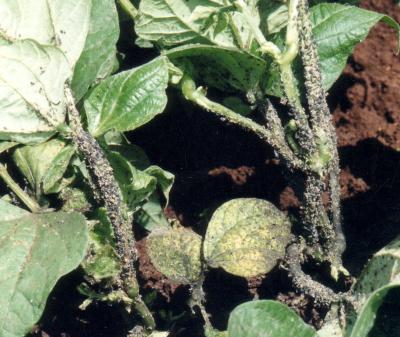

Main aphids in Africa: Black bean aphid ([i]Aphis fabae[/i]), Cabbage aphid ([i]Brevycoryne brassicae/Myzus persicae[/i]), Groundnut aphid ([i]A.craccivora[/i]), Cotton aphid ([i]A.gossypii[/i]), Russian wheat aphid ([i]Diuraphis noxia[/i]), Cypress aphid ([i]Cinara cupressi[/i])
Aphids (Aphis fabae) and (Aphis craccivora)
The black bean aphid (Aphis fabae) and the black legume aphid (Aphis craccivora) are black to dark brown brownish in colour and winged or wingless and vary in size from 1.5 to 3.0 mm. Aphids feed by sucking plant sap. Small aphid populations may be relatively harmless, but heavily infested plants usually have wrinkled leaves, stunted growth and deformed pods. Plants, in particular young plants, may dry out and die under heavy aphid attack. Heavy attack on older plants may cause crop loss by decreasing flower and pod production. Damage may also reduce seed viability.
In addition, plants may become contaminated by honeydew produced by aphids and sooty mould growing on honeydew. French beans contaminated with honeydew and / or sooty moulds are not marketable. Aphids are also vectors of diseases, including the bean common mosaic virus. The black bean aphid is a widely distributed pest of beans. The black legume aphid usually attacks beans grown at low altitudes.
- Conserve natural enemies. They are important in natural control of aphids. For more information on Natural enemies click here
- Monitor regularly the crop.
- Whenever necessary spray only infested plants (spot spraying).
- Use biopesticides that are not harmful to natural enemies (e.g. neem, ashes, soapy water). In Kenya, foliar sprays with neem products such as Neemroc® (1-3%) and Neemros® water extract (50 g/l) controlled the black bean aphid on French beans (Maundu, 1997). For more information on Biopesticides click here
